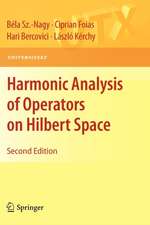Gesammelte Abhandlungen I: Springer Collected Works in Mathematics
Autor Carl Ludwig Siegel Editat de Komaravolu Chandrasekharan, Hans Maaßde Limba Germană Paperback – 16 dec 2015
In the wide range of his interests, in his capacity to uncover, to attack, and to subdue problems of great significance and difficulty, in his invention of new concepts and ideas, in his technical prowess, and in the consummate artistry of his presentation, SIEGEL resembles the classical figures of mathematics. In his combination of arithmetical, analytical, algebraical, and geometrical methods of investigation, and in his unerring instinct for the conceptual and structural, as distinct from the merely technical, aspects of any concrete problem, he represents the best type of modern mathematical thought. At once classical and modern, his work has profoundly influenced the mathematical culture of our time."
Volume I includes Siegel's papers writtenbetween 1921 and 1937.
Din seria Springer Collected Works in Mathematics
-
 Preț: 520.08 lei
Preț: 520.08 lei - 17%
 Preț: 369.37 lei
Preț: 369.37 lei -
 Preț: 500.64 lei
Preț: 500.64 lei -
 Preț: 522.95 lei
Preț: 522.95 lei -
 Preț: 519.51 lei
Preț: 519.51 lei -
 Preț: 484.69 lei
Preț: 484.69 lei -
 Preț: 506.63 lei
Preț: 506.63 lei -
 Preț: 512.56 lei
Preț: 512.56 lei - 15%
 Preț: 491.90 lei
Preț: 491.90 lei -
 Preț: 505.65 lei
Preț: 505.65 lei -
 Preț: 503.91 lei
Preț: 503.91 lei -
 Preț: 505.86 lei
Preț: 505.86 lei -
 Preț: 494.48 lei
Preț: 494.48 lei -
 Preț: 511.26 lei
Preț: 511.26 lei -
 Preț: 531.91 lei
Preț: 531.91 lei -
 Preț: 499.72 lei
Preț: 499.72 lei -
 Preț: 512.56 lei
Preț: 512.56 lei -
 Preț: 498.34 lei
Preț: 498.34 lei -
 Preț: 517.58 lei
Preț: 517.58 lei -
 Preț: 505.65 lei
Preț: 505.65 lei - 15%
 Preț: 501.48 lei
Preț: 501.48 lei -
 Preț: 512.01 lei
Preț: 512.01 lei -
 Preț: 516.25 lei
Preț: 516.25 lei -
 Preț: 498.91 lei
Preț: 498.91 lei - 15%
 Preț: 487.90 lei
Preț: 487.90 lei -
 Preț: 513.91 lei
Preț: 513.91 lei -
 Preț: 486.60 lei
Preț: 486.60 lei -
 Preț: 495.84 lei
Preț: 495.84 lei -
 Preț: 512.01 lei
Preț: 512.01 lei -
 Preț: 498.73 lei
Preț: 498.73 lei -
 Preț: 496.23 lei
Preț: 496.23 lei -
 Preț: 507.77 lei
Preț: 507.77 lei -
 Preț: 513.15 lei
Preț: 513.15 lei -
 Preț: 518.16 lei
Preț: 518.16 lei -
 Preț: 502.37 lei
Preț: 502.37 lei -
 Preț: 493.12 lei
Preț: 493.12 lei -
 Preț: 498.14 lei
Preț: 498.14 lei -
 Preț: 516.81 lei
Preț: 516.81 lei - 15%
 Preț: 483.76 lei
Preț: 483.76 lei -
 Preț: 504.28 lei
Preț: 504.28 lei -
 Preț: 522.41 lei
Preț: 522.41 lei -
 Preț: 524.71 lei
Preț: 524.71 lei -
 Preț: 500.64 lei
Preț: 500.64 lei -
 Preț: 514.90 lei
Preț: 514.90 lei -
 Preț: 485.84 lei
Preț: 485.84 lei -
 Preț: 517.73 lei
Preț: 517.73 lei -
 Preț: 519.69 lei
Preț: 519.69 lei - 15%
 Preț: 481.52 lei
Preț: 481.52 lei -
 Preț: 512.99 lei
Preț: 512.99 lei -
 Preț: 494.48 lei
Preț: 494.48 lei
Preț: 503.74 lei
Nou
Puncte Express: 756
Preț estimativ în valută:
96.39€ • 100.85$ • 80.07£
96.39€ • 100.85$ • 80.07£
Carte tipărită la comandă
Livrare economică 03-17 aprilie
Preluare comenzi: 021 569.72.76
Specificații
ISBN-13: 9783662488898
ISBN-10: 3662488892
Pagini: 560
Ilustrații: XI, 560 S.
Dimensiuni: 155 x 235 x 29 mm
Greutate: 0.79 kg
Ediția:1. Aufl. 1966, Reprint 2015 of the 1966 edition
Editura: Springer Berlin, Heidelberg
Colecția Springer
Seria Springer Collected Works in Mathematics
Locul publicării:Berlin, Heidelberg, Germany
ISBN-10: 3662488892
Pagini: 560
Ilustrații: XI, 560 S.
Dimensiuni: 155 x 235 x 29 mm
Greutate: 0.79 kg
Ediția:1. Aufl. 1966, Reprint 2015 of the 1966 edition
Editura: Springer Berlin, Heidelberg
Colecția Springer
Seria Springer Collected Works in Mathematics
Locul publicării:Berlin, Heidelberg, Germany
Public țintă
ResearchCuprins
Band I.- 1. Approximation algebraischer Zahlen.- 2. Approximation algebraischer Zahlen.- 3. Darstellung total positiver Zahlen durch Quadrate.- 4. Über Näherungswerte algebraischer Zahlen.- 5. Ueber die Coefficienten in der Taylorschen Entwicklung rationaler Funktionen.- 6. Ueber den Thueschen Satz.- 7. Neuer Beweis für die Funktionalgleichung der Dedekindschen Zetafunktion.- 8. Additive Theorie der Zahlkörper I.- 9. Bemerkungen zu einen Satz von Hamburger über die Funktionalgleichung der Riemannschen Zetafunktion.- 10. Über die Diskriminanten total reeller Körper.- 11. Neuer Beweis des Satzes von Minkowski über lineare Formen.- 12. Additive Zahlentheorie in Zahlkörpern.- 13. Neuer Beweis für die Funktionalgleichung der Dedekindschen Zetafunktion II.- 14. Additive Theorie der Zahlkörper II.- 15. The integer solutions of the equation y2 = axn + bxn?1 + ··· + k.- 16. Über einige Anwendungen diophantischer Approximationen.- 17. Über die Perioden elliptischer Funktionen.- 18. Über RiemannsNachlaß zur analytischen Zahlentheorie.- 19. Über Gitterpunkte in convexen Körpern und ein damit zusammenhängendes Extremalproblem.- 20. Über die analytische Theorie der quadratischen Formen.- 21. Über die Classenzahl quadratischer Zahlkörper.- 22. Über die analytische Theorie der quadratischen Formen II.- 23. Über die algebraischen Integrale des restringierten Dreikörperproblems.- 24. Mittelwerte arithmetischer Funktionen in Zahlkörpern.- 25. The volume of the fundamental domain for some infinite groups.- 26. Über die analytische Theorie der quadratischen Formen III.
Textul de pe ultima copertă
From the Preface (K. Chandrasekharan, 1966): "The publication of this collection of papers is intended as a service to the mathematical community, as well as a tribute to the genius of CARL LUDWIG SIEGEL, who is rising seventy.
In the wide range of his interests, in his capacity to uncover, to attack, and to subdue problems of great significance and difficulty, in his invention of new concepts and ideas, in his technical prowess, and in the consummate artistry of his presentation, SIEGEL resembles the classical figures of mathematics. In his combination of arithmetical, analytical, algebraical, and geometrical methods of investigation, and in his unerring instinct for the conceptual and structural, as distinct from the merely technical, aspects of any concrete problem, he represents the best type of modern mathematical thought. At once classical and modern, his work has profoundly influenced the mathematical culture of our time."
Volume I includes Siegel's papers writtenbetween 1921 and 1937.













